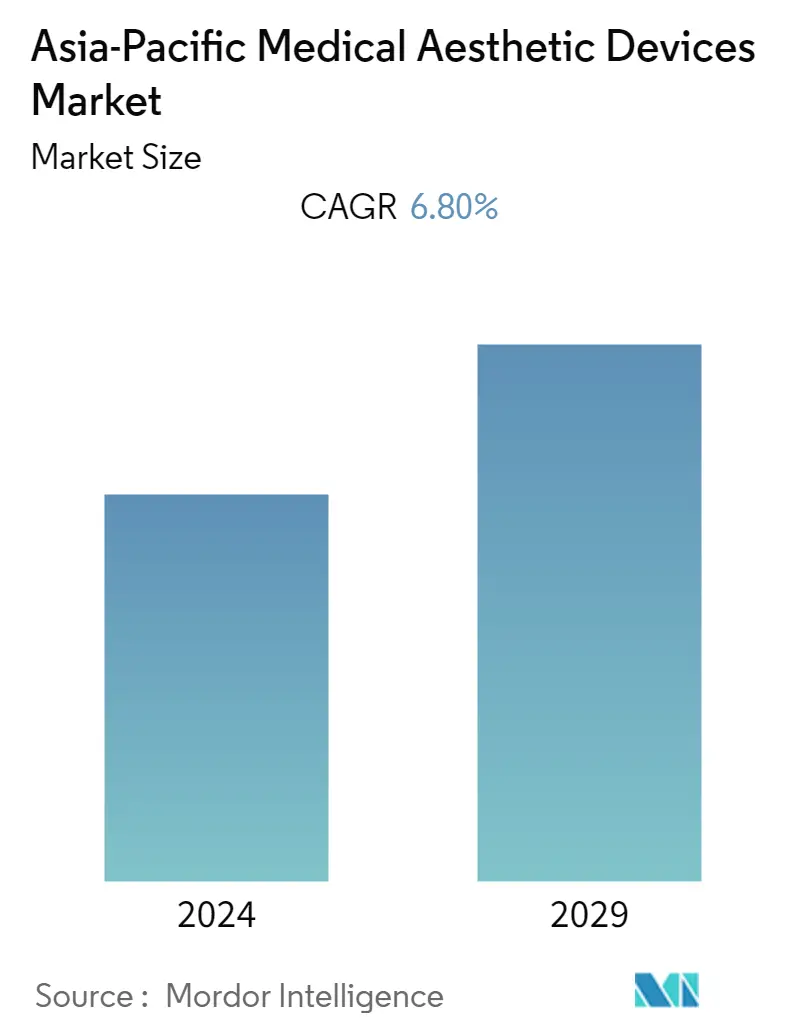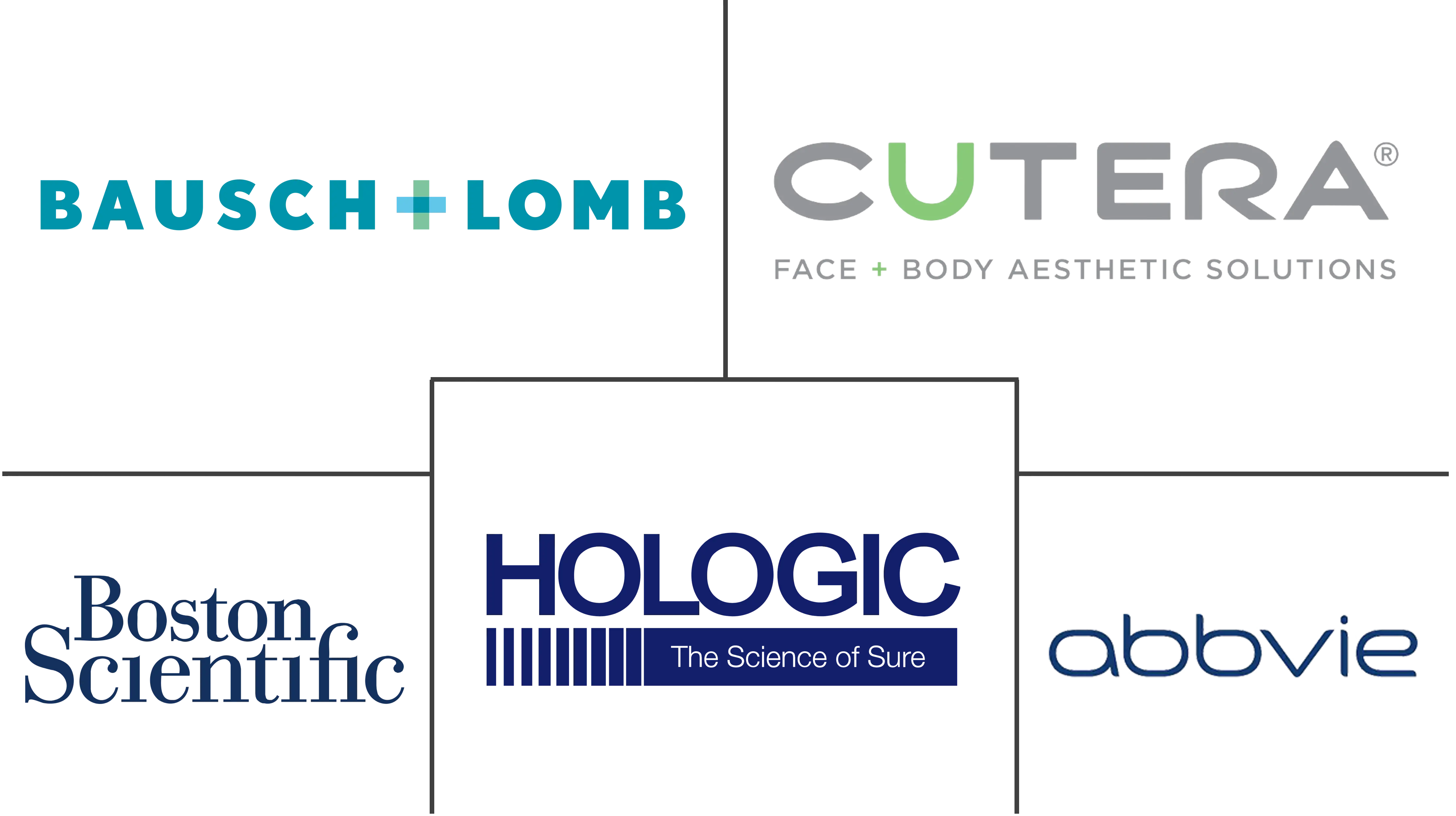Market Size of Asia-Pacific Medical Aesthetic Devices Industry

| Study Period | 2019 - 2029 |
| Base Year For Estimation | 2023 |
| Forecast Data Period | 2024 - 2029 |
| Historical Data Period | 2019 - 2022 |
| CAGR | 6.80 % |
Major Players
*Disclaimer: Major Players sorted in no particular order |
Asia-Pacific Medical Aesthetic Devices Market Analysis
The Asia-Pacific medical aesthetic devices market is poised to grow at a CAGR of 6.8% over the forecast period.
COVID-19 had a notable impact on the market over the pandemic period owing to strict regulations on elective surgeries, including aesthetic surgeries. For instance, according to an NCBI article published in January 2022, the COVID-19 pandemic dramatically decreased the number of patients who visited the COPD, were admitted to the IPD, and had elective procedures done in the plastic surgery department. Such circumstances had a significant impact on the demand for aesthetic devices in Asia-Pacific, thereby impacting the market growth over the pandemic period. However, now that COVID-19 restrictions have been relaxed and surgical services in dermatology and cosmetology clinics have resumed, the demand for aesthetic procedures is expected to increase, which in turn is anticipated to boost the demand for aesthetic devices over the forecast period.
Certain factors propelling the market growth are the technological advancements in devices, the rise in medical tourism in Asian countries, and the increasing obese population in Asia-Pacific.
The rising prevalence of obesity among the population is the key factor driving the market growth. For instance, according to the 2022 statistics published by the World Obesity Federation, 24% of women, 22.9% of men, and 23.4% of adults were obese in India during 2019-2021. Also, as per an NCBI article published in March 2022, it has been projected that more than 60% of Chinese adults would have abdominal obesity, and over two-thirds of Chinese adults are expected to be overweight or generally obese by 2030.
Furthermore, increasing advanced product launches by key market players are also expected to contribute to the growth of the market. For instance, in March 2021, Joonghun Pharmaceuticals launched the premium-cross linked hyaluronic acid derma filler, Aragon in South Korea.
Althought the market is expected to project growth over the forecast period, social stigma concerns and poor reimbursement scenarios are expected to restrain its growth over the forecast period.
Asia-Pacific Medical Aesthetic Devices Industry Segmentation
As per the scope of the report, aesthetic devices refer to all medical devices that are used for various cosmetic procedures, which include plastic surgery, unwanted hair removal, excess fat removal, anti-aging, aesthetic implants, skin tightening, and others, that are used for beautification, correction, and improvement of the body.
The Asia-Pacific medical aesthetic devices market is segmented by Type of Device (Energy-based Aesthetic Device (Laser-based Aesthetic Device, Radiofrequency (RF)-based Aesthetic Device, Light-based Aesthetic Device, Ultrasound Aesthetic Device), Non-energy-based Aesthetic Device (Botulinum Toxin, Dermal Fillers, and Aesthetic Threads, Chemical Peels, Microdermabrasion, and Implants), and Other Non-energy-based Aesthetic Devices), Application (Skin Resurfacing and Tightening, Body Contouring and Cellulite Reduction, Hair Removal, Tattoo Removal, Breast Augmentation, and Other Applications), End User (Hospitals, Clinics, and Other Settings) and Geography (China, Japan, India, Australia, South Korea, Rest of Asia-Pacific). The report offers the value (in USD million) for the above segments.
| Type of Device | |||||||||||
| |||||||||||
| |||||||||||
| Other Non-energy-based Aesthetic Devices |
| Application | |
| Skin Resurfacing and Tightening | |
| Body Contouring and Cellulite Reduction | |
| Hair Removal | |
| Tattoo Removal | |
| Breast Augmentation | |
| Other Applications |
| End User | |
| Hospitals | |
| Clinics | |
| Home settings |
| Geography | |
| China | |
| Japan | |
| India | |
| Australia | |
| South Korea | |
| Rest of Asia-Pacific |
Asia-Pacific Medical Aesthetic Devices Market Size Summary
The Asia-Pacific medical aesthetic devices market is experiencing a positive trajectory, driven by several key factors. The relaxation of COVID-19 restrictions has led to a resurgence in demand for aesthetic procedures, which is expected to boost the market's growth over the forecast period. Technological advancements in medical devices, coupled with the rise in medical tourism and an increasing obese population, are significant contributors to this growth. The prevalence of obesity in countries like India and China is a major driver, as it leads to a higher demand for aesthetic procedures. Additionally, the introduction of advanced products by key market players is further propelling the market forward. Despite these growth drivers, challenges such as social stigma and poor reimbursement scenarios may hinder market expansion.
The demand for dermal fillers and aesthetic threads is anticipated to rise, fueled by the growing geriatric population in the region. Aging-related skin dehydration is expected to increase the need for these products, thereby enhancing segment growth. The efficacy of dermal fillers, such as hyaluronic acid injections, is also contributing to their rising popularity, particularly for lip enhancements. Regulatory approvals for new products in the region are expected to further stimulate market growth. The Indian market, in particular, is poised for significant expansion due to increased awareness of aesthetic procedures, technological advancements, and the rising obesity rate. The market is moderately consolidated, with major global players expanding their presence through partnerships and distributorships in the Asia-Pacific region.
Asia-Pacific Medical Aesthetic Devices Market Size - Table of Contents
-
1. MARKET DYNAMICS
-
1.1 Market Overview
-
1.2 Market Drivers
-
1.2.1 Technological Advancement in Devices
-
1.2.2 Rise in Medical Tourism in Asian Countries
-
1.2.3 Increasing Obese Population
-
-
1.3 Market Restraints
-
1.3.1 Social Stigma Concerns
-
1.3.2 Poor Reimbursement Scenario
-
-
1.4 Porter's Five Forces Analysis
-
1.4.1 Threat of New Entrants
-
1.4.2 Bargaining Power of Buyers/Consumers
-
1.4.3 Bargaining Power of Suppliers
-
1.4.4 Threat of Substitute Products
-
1.4.5 Intensity of Competitive Rivalry
-
-
-
2. MARKET SEGMENTATION (Market Size by Value - USD million)
-
2.1 Type of Device
-
2.1.1 Energy-based Aesthetic Device
-
2.1.1.1 Laser-based Aesthetic Device
-
2.1.1.2 Radiofrequency (RF)-based Aesthetic Device
-
2.1.1.3 Light-based Aesthetic Device
-
2.1.1.4 Ultrasound Aesthetic Device
-
-
2.1.2 Non-energy-based Aesthetic Device
-
2.1.2.1 Botulinum Toxin
-
2.1.2.2 Dermal Fillers and Aesthetic Threads
-
2.1.2.3 Chemical Peels
-
2.1.2.4 Microdermabrasion
-
2.1.2.5 Implants
-
2.1.2.5.1 Facial Implants
-
2.1.2.5.2 Breast Implants
-
2.1.2.5.3 Other Implants
-
-
-
2.1.3 Other Non-energy-based Aesthetic Devices
-
-
2.2 Application
-
2.2.1 Skin Resurfacing and Tightening
-
2.2.2 Body Contouring and Cellulite Reduction
-
2.2.3 Hair Removal
-
2.2.4 Tattoo Removal
-
2.2.5 Breast Augmentation
-
2.2.6 Other Applications
-
-
2.3 End User
-
2.3.1 Hospitals
-
2.3.2 Clinics
-
2.3.3 Home settings
-
-
2.4 Geography
-
2.4.1 China
-
2.4.2 Japan
-
2.4.3 India
-
2.4.4 Australia
-
2.4.5 South Korea
-
2.4.6 Rest of Asia-Pacific
-
-
Asia-Pacific Medical Aesthetic Devices Market Size FAQs
What is the current Asia-Pacific Medical Aesthetic Devices Market size?
The Asia-Pacific Medical Aesthetic Devices Market is projected to register a CAGR of 6.80% during the forecast period (2024-2029)
Who are the key players in Asia-Pacific Medical Aesthetic Devices Market?
Bausch & Lomb Incorporated, Lumenis Inc., Cutera Inc., AbbVie (Allergan PLC) and Hologic, Inc. are the major companies operating in the Asia-Pacific Medical Aesthetic Devices Market.

